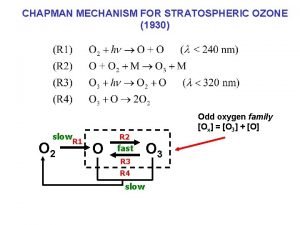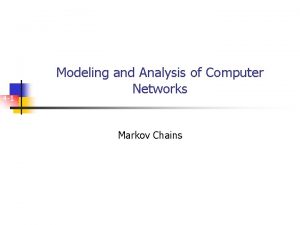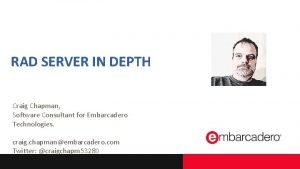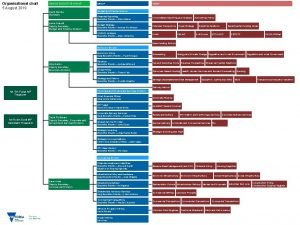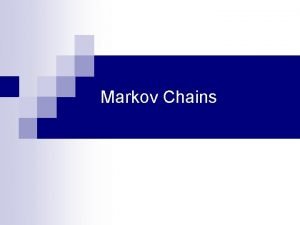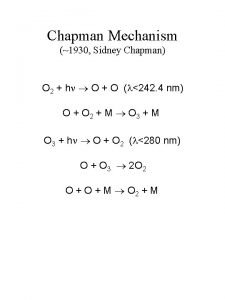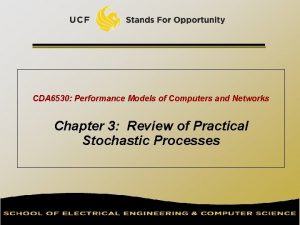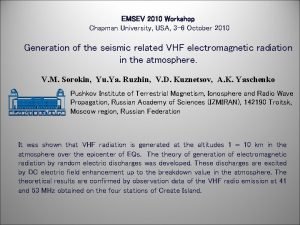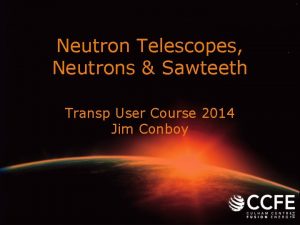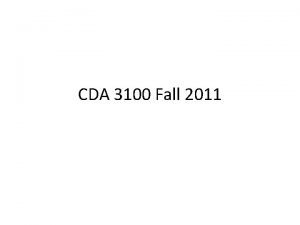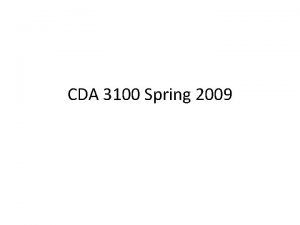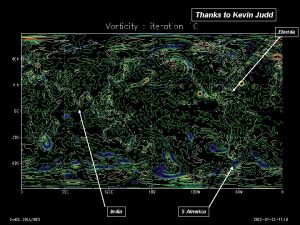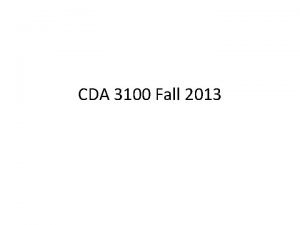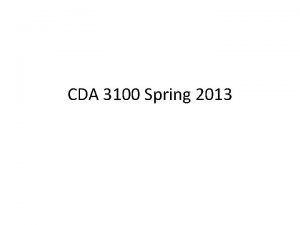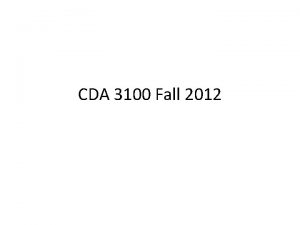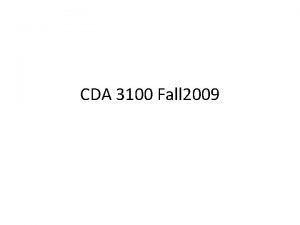The physics of sawteeth IT Chapman with thanks



![Reconnection in the Plasma Core Sawtooth oscillations cause rapid, periodic temperature collapse SXR [au] Reconnection in the Plasma Core Sawtooth oscillations cause rapid, periodic temperature collapse SXR [au]](https://slidetodoc.com/presentation_image_h/934f5d3b0bac985e98c0a257ff3e9d89/image-4.jpg)



























![Sawtooth Control in ITER • Triggering criteria for resistive n=1 kink [Porcelli, PPCF, 1996] Sawtooth Control in ITER • Triggering criteria for resistive n=1 kink [Porcelli, PPCF, 1996]](https://slidetodoc.com/presentation_image_h/934f5d3b0bac985e98c0a257ff3e9d89/image-32.jpg)






- Slides: 38

The physics of sawteeth IT Chapman with thanks to many collaborators EURATOM/CCFE Fusion Association, Culham Science Centre, Oxon, UK CCFE is the fusion research arm of the United Kingdom Atomic Energy Authority

An Overview Internal Kink Mode Destabilise kink mode + alphas Short sawteeth help to remove helium ash & don’t affect performance much 2 / 31 IT Chapman + + pressure Sawtooth Oscillations Drive current near mode location or introduce fast ions just outside mode location Long Sawteeth Neoclassical Tearing Modes Active Control of Instabilities in Hot Plasmas June 2011 radius

This talk • Phenomenology of sawteeth – Temperature evolution – Reconnection in the core – Sawtooth crash models • Triggering Neoclassical Tearing Modes – No physics mechanisms! Just empirical databases • Behaviour of sawteeth in hot plasmas – Effects of energetic particles – Effects of toroidal rotation 3 / 31 IT Chapman Active Control of Instabilities in Hot Plasmas June 2011
![Reconnection in the Plasma Core Sawtooth oscillations cause rapid periodic temperature collapse SXR au Reconnection in the Plasma Core Sawtooth oscillations cause rapid, periodic temperature collapse SXR [au]](https://slidetodoc.com/presentation_image_h/934f5d3b0bac985e98c0a257ff3e9d89/image-4.jpg)
Reconnection in the Plasma Core Sawtooth oscillations cause rapid, periodic temperature collapse SXR [au] ~ Te 12 Core: MAST Insight from <1 cm TS on MAST 8 4 Edge: 0. 31 0. 32 0. 33 Time [s] 0. 34 IT Chapman et al, PRL, 2010 4 / 31 IT Chapman Active Control of Instabilities in Hot Plasmas June 2011

Increasing temperature gradient • Te gradient increases as island width increases • Radial location of strongest Te moves to regions of lower magnetic shear IT Chapman et al, PRL, 2010 5 / 31 IT Chapman Active Control of Instabilities in Hot Plasmas June 2011

Reconnection in the Plasma Core TEXTOR • Crash occurs in nonchaotic way • Hot plasma surges through localised X-point, which can be on both HFS or LFS HK Park et al, PRL, 2006 6 / 31 IT Chapman Active Control of Instabilities in Hot Plasmas June 2011

Kadomtsev Model Ψ* (ii) (i) rmix r 1 rmix rs r 2 Final Flux Initial Flux q Ψ*(r 1) r 2 (iv) (iii) rmix Final q rmix r. K 1 Initial q 0 r 1 r 2 rmix • Full reconnection model – – 7 / 31 Current density in core rises, q drops below 1, drive 1/1 kink unstable Island grows pushing hot core to cooler plasma, flux reconnects Island growth predicts periodic collapse q<1; crash too fast compared to Sweet-Parker reconnection time Kadomtsev, Sov J Plasma Phys 1975 IT Chapman Active Control of Instabilities in Hot Plasmas June 2011

Only partial reconnection • Most machines observe that q<1 after the crash – DIII-D do observe complete reconnection in some cases MAST 8 / 31 IT Chapman Active Control of Instabilities in Hot Plasmas June 2011

Wesson Model • Quasi Interchange Model – Very flat q-profile with q>1 is unstable to QI mode – No magnetic reconnection – Driven unstable by change in q, which is not observed to be sufficiently significant – q<1 J Wesson, PPCF 1986 9 / 31 IT Chapman Active Control of Instabilities in Hot Plasmas June 2011

Trigger ballooning mode • Island leads to steep pressure gradient at boundary layer – When pressure gradient is steep enough, ballooning modes are driven unstable – Interrupts reconnection (not obvious which way fingers go!) – q<1 throughout – Accelerated reconnection time – Crash observed on HFS • TEXTOR and recently AUG MN Bussac et al, Phys Rev Lett 1984 TK Chu, Nucl Fusion 1988 10 / 31 IT Chapman Tokamak centre Nishimura et al, Phys Plasmas 1999 Active Control of Instabilities in Hot Plasmas June 2011

Trigger interchange mode • Strong pressure gradients also drive Mercier modes for q<1 – Resistive interchange predicted to become unstable as separatrix moves into region of sufficiently low shear Strong shaping can – Unstable for DI>1/4 where reverse Mercier stability! Competition between pressure gradient and magnetic shear Curvature effects mean Mercier stable for q>1 – Instability propagates pressure front towards axis (not outward since curvature is stabilising for q>1), driving fast crash, Gimblett and Hastie PPCF 36 1439 (1994) 11 / 31 IT Chapman Active Control of Instabilities in Hot Plasmas June 2011

When will a sawtooth crash happen? • Sawtooth is triggered when one of three criteria is met [Porcelli et al, PPCF, 38, 2163 (1996)] – Most relevant for plasmas with energetic ions is: Change in potential energy of internal kink mode Magnetic shear at q=1 surface • So a sawtooth crash occurs when: – The potential energy of the kink mode is sufficiently small – The magnetic shear at q=1 is sufficiently large 12 / 31 IT Chapman Ion Larmor radius Radius of q=1 surface q ~s 1 1 Active Control of Instabilities in Hot Plasmas r 1 June 2011 r

This talk • Phenomenology of sawteeth – Temperature evolution – Reconnection in the core – Sawtooth crash models • Triggering Neoclassical Tearing Modes – No physics mechanisms! Just empirical databases • Behaviour of sawteeth in hot plasmas – Effects of energetic particles – Effects of toroidal rotation 13 / 31 IT Chapman Active Control of Instabilities in Hot Plasmas June 2011

Sawteeth trigger other instabilities • Tokamak plasmas can cope with small drop in performance caused by sawteeth • Long Sawteeth have been shown to trigger Neoclassical Tearing Modes (NTMs) [Sauter et al, PRL, 88, 2002] 15 k. Hz Magnetics: 4/3 3/2 #58884 only 2/1 Expanded in time: 15 -18 s 0 b. N termination SXR/a. u. – Long Sawteeth NTMs long sawtooth – Short Sawteeth Avoid NTMs • NTMs seriously degrade plasma confinement NBI/MW ICRH/MW Time (s) 14 / 31 IT Chapman JET Active Control of Instabilities in Hot Plasmas June 2011

NTMs degrade plasma confinement • NTM causes ~15 -20% drop in confinement Plasma Pressure Profile t ea NT M He H at pressure [Chang and Callen, 1990] distance from centre • See talks by Sauter and Maraschek later today 15 / 31 IT Chapman Active Control of Instabilities in Hot Plasmas June 2011

NTM Triggering • NTM triggering strongly correlated with sawtooth JET • Triggering of NTM exhibits much stronger correlation with sawtooth period than with amplitude Buttery et al, Nucl Fusion 2003 16 / 31 IT Chapman Active Control of Instabilities in Hot Plasmas June 2011

Link between ST period and NTMs • Trimming data to include only: – [0. 3, 0. 4], [1. 65, 1. 85], r 1/a [0. 3, 0. 45], Paux/PL-H [1. 3, 1. 7] ITER IT Chapman et al, Nucl Fusion, 2010 17 / 31 IT Chapman Active Control of Instabilities in Hot Plasmas June 2011

ITER Context • Empirical scaling works reasonably well for data in ITER-like set – Transport modelling gives natural st in range 20 -70 s – Empirical database suggests st < 70 s to avoid NTMs ITER Filled = expt data Open = scaling prediction 18 / 31 IT Chapman ≈70 s Active Control of Instabilities in Hot Plasmas June 2011

This talk • Phenomenology of sawteeth – Temperature evolution – Reconnection in the core – Sawtooth crash models • Triggering Neoclassical Tearing Modes – No physics mechanisms! Just empirical databases • Behaviour of sawteeth in hot plasmas – Effects of energetic particles – Effects of toroidal rotation 19 / 31 IT Chapman Active Control of Instabilities in Hot Plasmas June 2011

Passing Particle Stabilisation Mechanism δW has a term dependent upon curvature: B Z Counterpassing Co-passing B Z q=1 surface R Good Curvature Adverse Curvature Co-pass, ‹Ph›’|r 1 < 0 → stabilising Co-pass, ‹Ph›’|r 1 > 0 → destabilising R Good Curvature Adverse Curvature Ctr-pass, ‹Ph›’|r 1 < 0 → destabilising Ctr-pass, ‹Ph›’|r 1 > 0 → stabilising Graves, Phys Rev Lett, 2004 20 / 31 IT Chapman Active Control of Instabilities in Hot Plasmas June 2011

Effect of Passing Energetic Ions • Highly localised outward pointing force (destabilisation) on both sides of the torus for a case with: • Obtain an inward pointing force (stabilisation) if one of the two conditions above are reversed • Effect increases with orbit width Trapped 21 / 31 IT Chapman Co Passing Active Control of Instabilities in Hot Plasmas Counter Passing June 2011

Off-axis NBI Effects in ASDEX Upgrade • Off-axis NBI affects sawtooth behaviour – As fh moves further outside q=1, s decreases by ~50% – Modelling again shows passing ions dominate over NBCD τ = 93 ms τ = 71 ms τ = 64 ms SXR (au) AUG Chapman et al, Phys Plasmas 2009 22 / 31 IT Chapman Active Control of Instabilities in Hot Plasmas June 2011

Asymmetric Fh in toroidally propagating ICRF Waves • Theory extended for toroidally propagating ICRF waves • Parallel velocity asymmetry in Fh seen e. g. in the ICRH current from SELFO jh (MA/m 2) Passing ion current(-90 phasing) Excess of co-passing ions Excess of cntr-passing ions r (m) rres Graves et al, PRL, 2009 23 / 31 IT Chapman Active Control of Instabilities in Hot Plasmas June 2011

Asymmetric Fh in toroidally propagating ICRF Waves • Theory extended for toroidally propagating ICRF waves • Parallel velocity asymmetry in Fh seen e. g. in the ICRH current from SELFO jh (MA/m 2) Passing ion current(-90 phasing) r 1 in here is destabilising r (m) rres Graves et al, PRL, 2009 24 / 31 IT Chapman Active Control of Instabilities in Hot Plasmas June 2011

Asymmetric Fh in toroidally propagating ICRF Waves • Theory extended for toroidally propagating ICRF waves • Parallel velocity asymmetry in Fh seen e. g. in the ICRH current from SELFO Passing ion current(-90 phasing) Sawtooth Period jh (MA/m 2) 76189 r 1 in here is destabilising rinv-rres r (m) rres Graves et al, PRL, 2009 25 / 31 JET IT Chapman Active Control of Instabilities in Hot Plasmas June 2011

Modelling n=1 Kink Mode Stability HELEN A (1) Equilibrium configuration MISHKAF ASCOT TRANS P SCENI C SELFO (1) (2) (3) (4) (5) (6) (7) (3) (2) δWMHD Eigenfunction (7) α distribution HAGIS (4) (5) (6) δWh Wave & Particle Evolution NBI distribution ICRH distribution Evaluate linear crash trigger criteria: Huysmans et al, CP 90 Conf on Comput Phys, p 371 (1990) Chapman et al, Phys Plasmas, 13, 062511 (2006) JA Heikkinen et al, Comput. Phys. Comm. , 76, 215 (1993) Budny et al, Nucl Fusion, 32, 429 (1992) Jucker et al, Comp Phys Comms, in press (2011) Hedin et al, Nucl Fusion, 42, 527 (2002) Pinches et al, Comput Phys Commun, 111, 133 (1998) 26 / 31 IT Chapman Active Control of Instabilities in Hot Plasmas June 2011

Fast ion effects on sawteeth Counter-NBI Co-NBI δW Counter-NBI JET – Minima in sawtooth period and δWh agree well (at ~ 4 MW) • Minimum occurs because flow shear inhibits trapped particle stabilising effect at low flows Chapman et al, PPCF, 2007 27 / 31 IT Chapman Active Control of Instabilities in Hot Plasmas June 2011

Effect of alphas • Alpha particles are very strongly stabilising – Balance of Pα and total Pα mean that optimal stabilisation occurs for q=1 radius at approximately that expected in baseline scenarios! ITER δŴ Equilibrium q=1 r 1 / a 28 / 31 IT Chapman et al, sub PPCF 2011 Active Control of Instabilities in Hot Plasmas June 2011

Benchmarking alpha stabilisation • JET D-T campaign did not exhibit significant dependence of sawtooth period upon α fraction are α’s really important? • ICRH+NBI ions dominate 16 MW α’s for sawtooth behaviour JET δŴ HAGIS calcs using analytic approximation for NBI distribution NB: Only one sawtooth, not averaged Nave et al, Nucl Fusion 2002 ηT=60% ηT=92% • ηT dependence arises since triton orbit widths are larger and take longer to slow down meaning δWNBI is larger 29 / 31 IT Chapman Active Control of Instabilities in Hot Plasmas June 2011

Rotation affects sawtooth behaviour • Kink mode stabilised by strong toroidal rotation – Requires more free energy to kink plasma when rotating fast due to centrifugal forces – In spherical tokamaks, rotation can approach ion sound speed MAST *i JE T Sawtooth Period (s) 0. 04 MAST 0. 03 0. 02 0. 01 -2 Counter-NBI Co-NBI 30 / 31 IT Chapman -1 1 0 NBI Power (MW) Counter-NBI 2 Co-NBI Chapman et al, Nucl Fusion, 2006 Active Control of Instabilities in Hot Plasmas June 2011

Physics of Sawteeth • Periodic collapses in temperature profile – Very well diagnosed plasmas give insight to partial reconnection process • Heat pulse can occur on both LFS and HFS • Increase in local P as island grows – A number of different models exist; all have pros and cons • Longer sawtooth period shown to trigger NTMs at lower plasma pressures • Energetic ions strongly affect stability – Trapped ions are strongly stabilising – Co-passing on-axis are stabilising – Counter on-axis & Co- off-axis are destabilising 31 / 31 IT Chapman Active Control of Instabilities in Hot Plasmas June 2011
![Sawtooth Control in ITER Triggering criteria for resistive n1 kink Porcelli PPCF 1996 Sawtooth Control in ITER • Triggering criteria for resistive n=1 kink [Porcelli, PPCF, 1996]](https://slidetodoc.com/presentation_image_h/934f5d3b0bac985e98c0a257ff3e9d89/image-32.jpg)
Sawtooth Control in ITER • Triggering criteria for resistive n=1 kink [Porcelli, PPCF, 1996] In ITER, will be small and r 1 will be large pressure Alphas and NBI will stabilise the internal kink, increasing saw Planned control via ECCD to increase local shear Passing ions from ICRH can destabilise sawteeth Seed NTMs NB: He 3 minority small ICCD Current + q=1 radius 32 / 31 IT Chapman Active Control of Instabilities in Hot Plasmas June 2011

• Back ups 33 / 31 IT Chapman Active Control of Instabilities in Hot Plasmas June 2011

9 What is the rôle of trapped and passing particles? • Sawtooth stabilisation by energetic particles is usually attributed to the presence of trapped fast ions [Porcelli, PPCF, 33, 1991] • HAGIS code Counter - NBI Co – NBI δWh – In JET, fast beam ions are mainly passing – Passing ions can be stabilising when co-NBI, but destabilising when counter. NBI. [Graves, PRL, 92, 2004] – Drift Kinetic code for exploring wave-particle interactions – Calculates change in potential energy: Higher order terms means δWh ≠ 0 for balanced beams Asymmetry Coefficient = [P(co)-P(ctr)] / P(Total) Pinches, CPC, 111, 1998 34 / 31 IT Chapman Active Control of Instabilities in Hot Plasmas June 2011

11 Effects of Flow Shear • Flows change the electric field by adding a factor: NB: Electric potential depends on direction of rotation • The flow shear can change number of particles in resonance. δWh > 0 when: Re(δWh) δWh Im(δWh) δWh Graves, PPCF, 42, 2000 HAGIS Modelling ΔΩ – At very large flows (ΔΩ > ‹ωd›) flow shear dominates the numerator and denominator of expression for δWh → asymptotic limit 35 / 31 IT Chapman Active Control of Instabilities in Hot Plasmas June 2011

12 How does δWh change with respect to beam power? δW • Modelling the effect of energetic particles on the ideal n=1 internal kink mode WITHOUT flow shear in JET: 36 / 31 IT Chapman Active Control of Instabilities in Hot Plasmas June 2011

13 How does δWh change with respect to beam power? δW • Modelling the effect of energetic particles on the ideal n=1 internal kink mode WITH flow shear in JET: Chapman et al, Phys Plasmas, 2007 37 / 31 IT Chapman Active Control of Instabilities in Hot Plasmas June 2011

Link between ST period and NTMs ITER 10 s 100 s IT Chapman et al, Nucl Fusion, 2010 38 / 31 IT Chapman Active Control of Instabilities in Hot Plasmas June 2011
 Chapman declining balance
Chapman declining balance Chapman mechanism
Chapman mechanism Carrie chapman catt the crisis
Carrie chapman catt the crisis Prostate chapman point
Prostate chapman point Embedded markov chain
Embedded markov chain Rad server
Rad server Chapman microsoft office
Chapman microsoft office Microsoft pdg
Microsoft pdg Chelsey chapman
Chelsey chapman Frank chapman outdoor education centre
Frank chapman outdoor education centre Simone aria
Simone aria Dr archie chapman
Dr archie chapman Chapman university greek life
Chapman university greek life Marian chapman dtf
Marian chapman dtf Chapman kolmogorov equation
Chapman kolmogorov equation Lisa chapman ubs
Lisa chapman ubs Aitor arauz chapman
Aitor arauz chapman Robbin chapman
Robbin chapman Chapman mechanism
Chapman mechanism Pdg microsoft
Pdg microsoft Mark david chapman catcher in the rye
Mark david chapman catcher in the rye Electrostatic meter chapman
Electrostatic meter chapman Chapman reflexes
Chapman reflexes Cayuse irb chapman
Cayuse irb chapman Qqq cda
Qqq cda Edgardo chapman
Edgardo chapman Annie chapman
Annie chapman Ecr rod supplier
Ecr rod supplier Chapman panther partner
Chapman panther partner Margaret chapman md
Margaret chapman md Fungsi seni budaya
Fungsi seni budaya Chapman student business services
Chapman student business services Edgardo chapman
Edgardo chapman Gary chapman love language test
Gary chapman love language test On first looking into chapman's homer 해석
On first looking into chapman's homer 해석 Chapman flask moisture chart
Chapman flask moisture chart Chapman university
Chapman university Lenora chapman
Lenora chapman Burwardsley outdoor education centre
Burwardsley outdoor education centre

